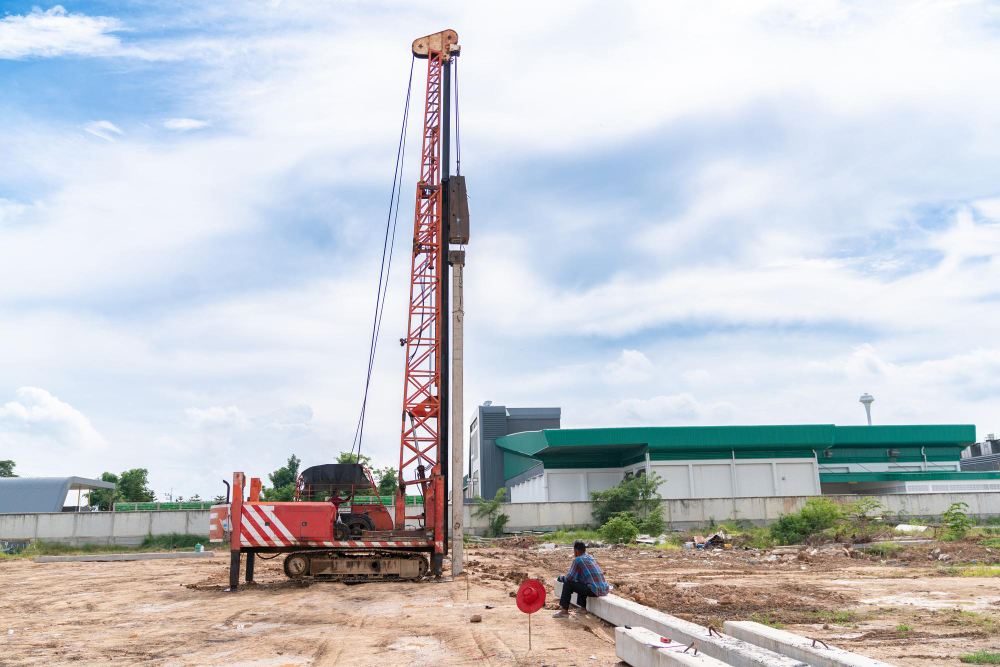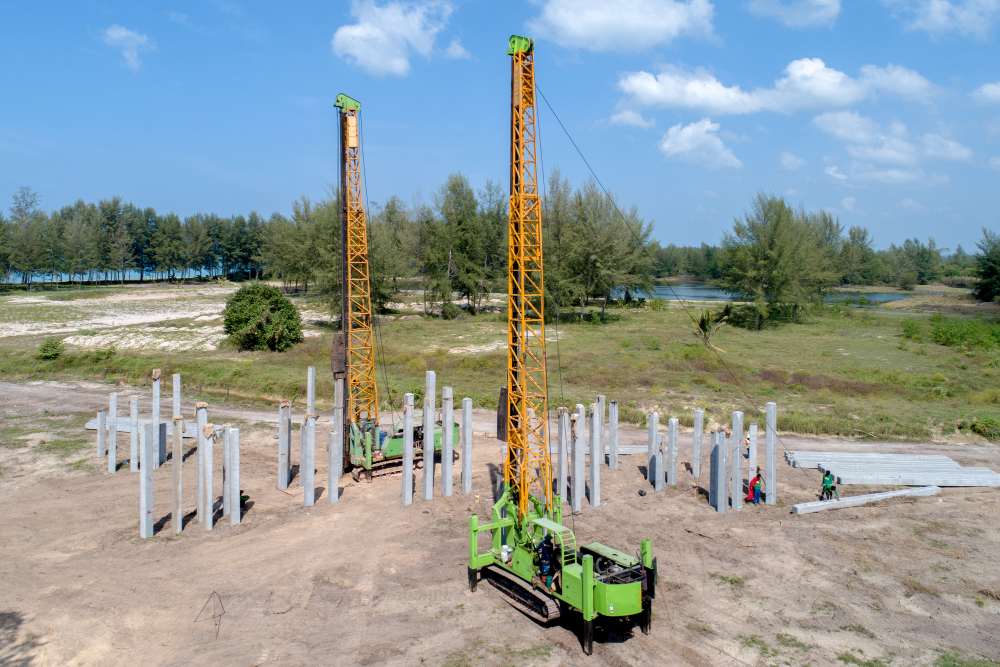When it comes to building bridges, piers, or large structures near or in water, a standard foundation just won’t do. In such challenging conditions, engineers often turn to a specialised deep foundation method known as a caisson foundation. But what exactly is it, how does it work, and why is it preferred in certain projects?
In this guide, we explore everything you need to know about caisson foundations – from what they are, to the different types, how they are constructed, and the advantages they offer.
What Is a Caisson Foundation?
A caisson foundation is a watertight retaining structure used in the construction of foundations for large buildings, bridges, or marine works. It’s designed to reach deep, stable layers of soil or rock, especially in waterlogged or unstable conditions. The structure is usually cylindrical or rectangular and may be constructed from concrete, steel, or wood.
Unlike traditional foundations that are laid on the surface or shallow depth, caisson foundations are sunk into the ground or waterbed to provide support in locations where surface soils are too weak to bear loads.
Where and When Are Caisson Foundations Used?
Caisson foundations are typically used in the following scenarios:
Bridge Piers and Abutments
Due to their strength and resistance to water infiltration, caissons are ideal for supporting bridge piers that stand in rivers or estuaries, where other foundations would be vulnerable to scour or erosion.
Marine or Offshore Structures
Caissons provide watertight and highly stable support in submerged conditions, making them indispensable in the construction of ports, harbours, and offshore terminals.
High-Rise Buildings in Water-Prone Areas
In cities with weak or waterlogged subsoil, caisson foundations are used to anchor tall structures to deep rock layers, ensuring stability against settlement or shifting.
Heavy Industrial Structures
Refineries, power plants, and other industrial facilities often require caisson foundations where ground conditions are unsuitable for shallow foundations and the structures impose substantial loads.
Seismic or Flood-Prone Zones
Caisson foundations can offer enhanced resistance to lateral forces, making them effective in earthquake-sensitive or flood-prone regions.
They are especially useful where water needs to be kept out during construction or where traditional piling methods are impractical due to excessive depth, poor soil, or the need for greater precision and durability.

Types of Caisson Foundations
There are several types of caissons, each with a unique design suited to specific construction needs. The choice depends on soil conditions, water depth, load requirements, and ease of construction. Below are the main types with more detail on their features and typical applications:
Open Caisson
Open caissons are open at both the top and bottom ends. These are constructed above ground and gradually sunk into position by excavating soil from inside the structure. As soil is removed, the caisson sinks deeper under its own weight. This type is suitable for shallow depths and where the groundwater level is manageable. It’s commonly used for bridge piers in riverbeds where dry working conditions can be maintained using pumps.
Box Caisson
A box caisson is a prefabricated, hollow, watertight box with a closed bottom and open top. It is built on land and floated or transported to the construction site, where it’s positioned over a prepared base and filled with concrete to provide permanent support. This type is ideal for underwater foundations in shallow waters, such as docks and jetties, as it requires minimal excavation.
Pneumatic Caisson
This type of caisson is sealed at the bottom and pressurised with air to keep water and soil out during excavation. Workers enter the caisson through airlocks and manually remove soil within a controlled environment. Pneumatic caissons are suited for very deep foundations and are often used in large bridge or pier construction. The pressurised chamber allows work to continue even under high water tables.
Floating Caisson
Floating caissons are constructed in dry docks and then floated to the desired location. Once positioned, they are sunk by filling them with water or concrete. These caissons are useful in marine construction or where rapid installation is needed. They’re commonly used for breakwaters, harbour walls, or permanent offshore foundations.
Monolithic Caisson
Monolithic caissons are massive, solid blocks (usually of reinforced concrete) cast as a single unit. They are used for projects requiring high resistance to impact or heavy loads, such as offshore oil platforms or sea defences. Due to their large size and weight, they offer extreme durability but require significant planning and transportation logistics.

Construction Process of a Caisson Foundation
The method of construction can vary depending on the type of caisson, but a general process includes several key stages, each requiring precision engineering and careful execution:
- Site Investigation: Before anything is built, a thorough geotechnical survey is conducted to evaluate soil composition, load-bearing capacity, water table depth, and any environmental challenges. This stage informs the design and feasibility of using caissons.
- Design and Planning: Engineers design the caisson structure based on site-specific conditions. This includes determining the size, shape, materials, and method of installation. Detailed drawings and calculations ensure compliance with building regulations and long-term performance.
- Fabrication: Caissons are typically prefabricated using reinforced concrete, steel, or a combination of both. This stage may occur off-site in controlled conditions to ensure quality and precision. For box or floating caissons, the units are built watertight and made ready for transport.
- Positioning: The prefabricated caisson is transported to the construction site by cranes, barges, or floating methods. Precision positioning is critical to align the structure correctly with foundation plans, especially for marine or bridge installations.
- Excavation or Sinking: Depending on the caisson type, it is sunk into the ground by removing soil (open and pneumatic types), by its own weight, or by controlled flooding (floating types). In pneumatic caissons, workers inside the chamber excavate soil under pressure to allow deeper installation.
- Sealing and Filling: Once the caisson reaches the desired depth, the base is sealed with concrete or other material. The interior may be filled with reinforced concrete to stabilise the structure and support future loads.
- Capping and Integration: A reinforced concrete cap or pile cap is constructed at the top of the caisson to tie it in with the above-ground structure. This final integration ensures uniform load transfer from the superstructure to the deep foundation.
Advantages of Caisson Foundations
- Stability: Reaches firm strata, providing high load-bearing capacity.
- Durability: Especially strong in underwater or marine conditions.
- Watertightness: Ideal for structures requiring dry working conditions during construction.
- Cost-Effective for Deep Foundations: Particularly when compared to driving piles in hard-to-reach locations.
- Versatility: Can be customised in size and shape depending on the project needs.
Limitations to Consider for Caisson Foundations
- High Initial Cost: Design, fabrication, and installation can be expensive.
- Complex Equipment and Labour: Requires skilled teams and sometimes pressurised working environments.
- Time-Intensive: Particularly for large or deep caisson installations.
Conclusion
Caisson foundations are a powerful solution for deep, stable support in challenging ground and water conditions. Though more complex than traditional methods, their strength, durability, and reliability make them indispensable in modern engineering.
If your project involves marine construction, bridge building, or unstable soils, our experienced team can help assess and deliver the right foundation system.
Contact us today for expert advice and tailored foundation solutions.
Frequently Asked Questions !
Are caisson foundations only used underwater?
No, they are also used on land where deep, stable foundations are required in weak or shifting soils.
What’s the difference between a caisson and a pile?
Piles are long, slender columns driven or bored into the ground, while caissons are larger, watertight boxes or cylinders sunk into place.
Is a caisson foundation suitable for residential buildings?
Rarely. Caissons are typically used for large infrastructure or commercial projects.
How deep can caisson foundations go?
They can extend tens of metres below the ground, depending on soil conditions and structural requirements.


